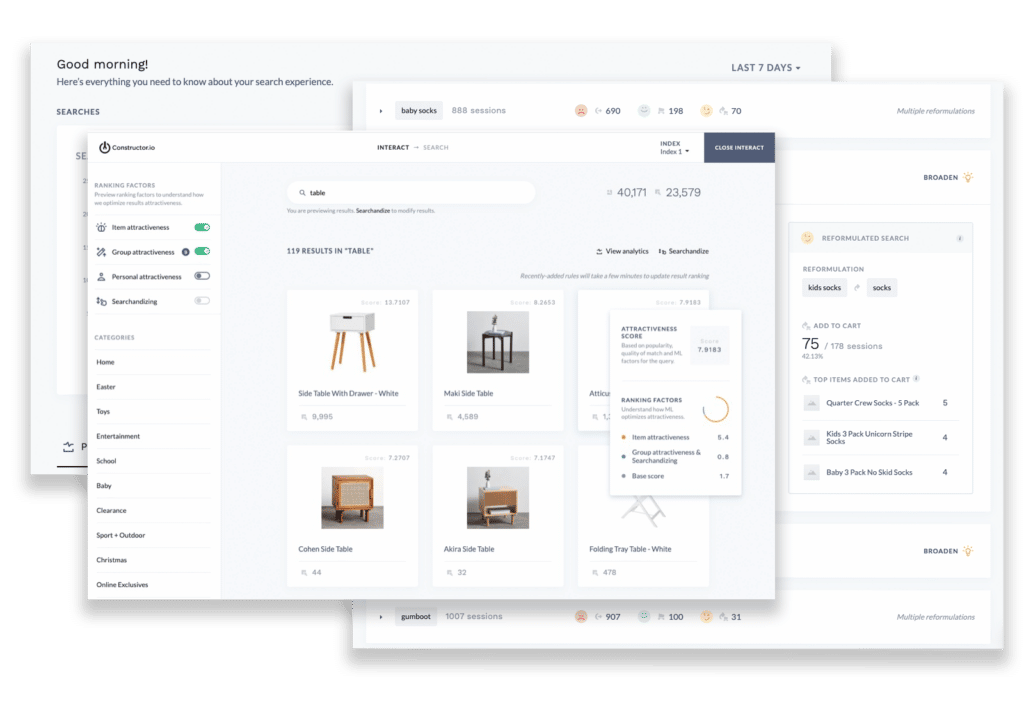 Amanda Nutbrown-Bourdeau is a former product manager and ecommerce lead at Best Buy Canada, where she worked for nearly 10 years. As Product Manager at Constructor, Amanda helps ecommerce retailers and their online merchandising teams leverage the power of AI to create personalized customer experiences and drive key business metrics.
Amanda Nutbrown-Bourdeau is a former product manager and ecommerce lead at Best Buy Canada, where she worked for nearly 10 years. As Product Manager at Constructor, Amanda helps ecommerce retailers and their online merchandising teams leverage the power of AI to create personalized customer experiences and drive key business metrics.
2021 was a challenging year for ecommerce companies between a global pandemic, rampant supply chain issues, and sizable employee turnover. We spoke with Amanda about the challenges facing merchandising teams and how they might be able to tackle them proactively.
Walk us through a day in the life of an online merchandiser. What’s likely to be on their plates?
When I think back on my time at Best Buy Canada in the ecommerce team, I can say that merchandisers are the connection to the online customer. They’re crucial to a good customer experience. They ensure that customers are easily able to find the products they’re looking for. They clearly communicate promotions across the customer journey in places like search, category pages, and landing pages. Digital merchandisers also often need to consider the offsite experience for omnichannel marketing campaigns. They’re thinking about visual assets and linking strategies and copy to ensure that those experiences are seamless for their customers.
The process will depend on organizational structure, but it typically involves collaboration with multiple teams like buyers and marketing. For omnichannel retailers, that could include collaboration with retail operations as well. After all this planning comes execution: optimizing on site experiences, ensuring events like sales and product launches are well represented, maybe setting up special landing pages. After online merchandising teams set all this up, they run through checks to make sure that the experience is just right. This tends to be a lot of heads down in the tools work for teams.
In my experience the biggest challenge here has just been balancing it all. Today a lot of teams are doing manual site merchandising (often at a SKU level!), and it’s a lot to keep up with. Not only does this manual merchandising take up a lot of time in itself, but then there’s reacting to unforeseen or unexpected results. Say a hero SKU is over performing and you need to re-merchandise it across the site because it sold out, or it’s under performing so you give it more prominent placement. This can be stressful given the volume of work to be done and the hard deadlines that are often in place.
The supply chain crisis and the pandemic have added more challenges than usual. What has the last year or two looked like from that perspective?
Going into the second year in a row with restrained inventory in a lot of categories is difficult. And we’re not just dealing with low inventory, we’re also seeing increased volumes and shipping times for backordered items. In past years, everything shipped around the same time. Now, while some products will be available immediately, we’re seeing others take as much as six months or more to ship because of supply chain issues. This puts standard practices around substitute or backup products to the test.
In 2020 we saw demand online spike in ways we’ve never experienced before. Now at the end of 2021, in-person shopping is open again but for a lot of reasons customers still want to shop online. While I don’t think anyone is expecting in-store shopping to return to pre-pandemic levels anytime soon, it’s definitely higher than last year. So all of this just makes knowing where to allocate your inventory tricky. The increased volatility for inventory puts greater pressure on merchandisers to maintain a positive onsite experience for their customers.
But another interesting element we’re beginning to see is that those who are returning to in-store shopping are likely to be doing more research online ahead of time. This of course existed before, though it was always a bit tricky to measure the extent, but the last 20 months or so really forced a lot of people to get comfortable with that online browsing and shopping experience. As a result, I don’t think we can underestimate the importance of your onsite experience feeding your in-store demand. At Constructor, we’re seeing this trend repeating time and time again with renewed focus on Buy Online, Pickup in Store (BOPIS) and using in-store purchasing data to power online experiences.

Across all industries, we’re seeing employees leaving high-stress jobs and looking for what they consider to be more fulfilling work. Do you think this trend extends to ecommerce and specifically to online merchandising teams?
Ecommerce certainly is not immune to this. When I remember the work I did as a merchandiser and what is common for the role in the industry even still today, it can be largely manual and reactive. That leaves teams feeling like they have little control over their work. For example, there’s not much excitement about manually boosting a specific category for a given search term to ensure that chicken dog food doesn’t outrank actual chicken for the search “chicken.”
Merchandisers still spend a lot of time in suboptimal or aging online merchandising tools, putting out fires. And without enough hours in the day, teams end up cutting other activities like strategic planning or digging into insights to really drive KPIs. And that’s the kind of work that a lot of people find fulfilling. It’s hard to really feel the impact of your work when you’re manually moving products around the site all day.
What solutions exist that can help shift the focus and get search product managers and merchandisers out of the trenches?
A critical part of a customer’s journey onsite is what they experience in search and browse. There is often a lot of manual effort that goes into ensuring that what customers see is optimized. But there are two key things that people can do to get out of this cycle. The first is to use the behavioral customer data you’re already collecting on your site. How can you apply it to help improve the experience in an automated way? The second is to think broadly about the types of scenarios that apply to your business. What are online merchandising teams or product managers spending a lot of time optimizing for on a category or even SKU level?
Thinking about these scenarios at this level can allow merchandisers (and other teams across the business) to envision what they want to happen. Maybe products with low or no inventory are suppressed across the catalog. Maybe new products or newly discounted products are boosted.
Then what can make sense in many scenarios is what we call “managing by exception.” For example maybe you suppress your low inventory products but you know customers are still looking for a given hero SKU. You could boost that in results so that you’re not forcing customers to dig for it and become frustrated. And then to further enhance that experience, you could position a substitute product right beside it. In taking an approach like this, you’re adjusting maybe a handful of SKUs instead of substantially more…

